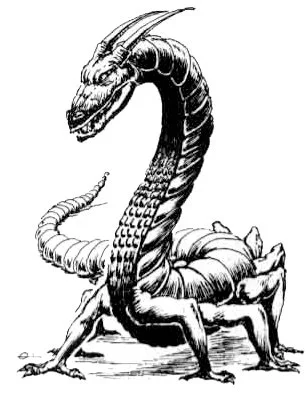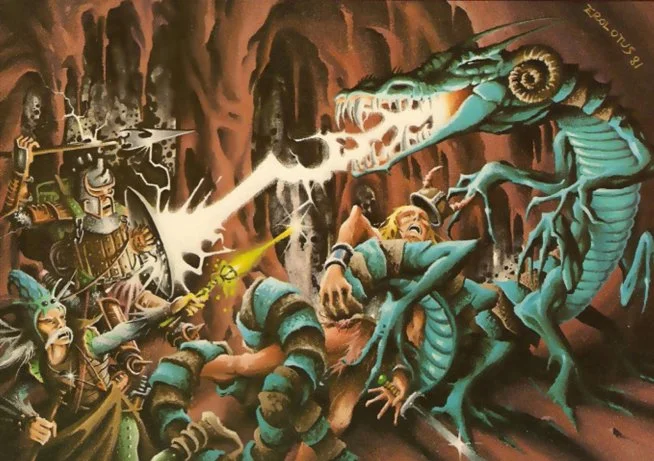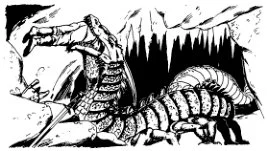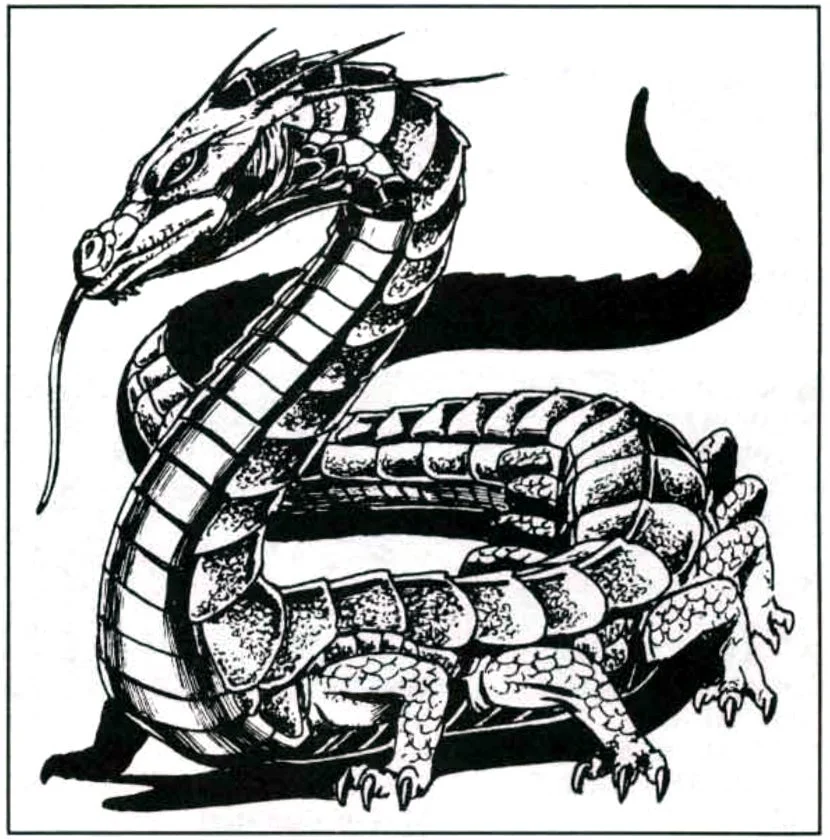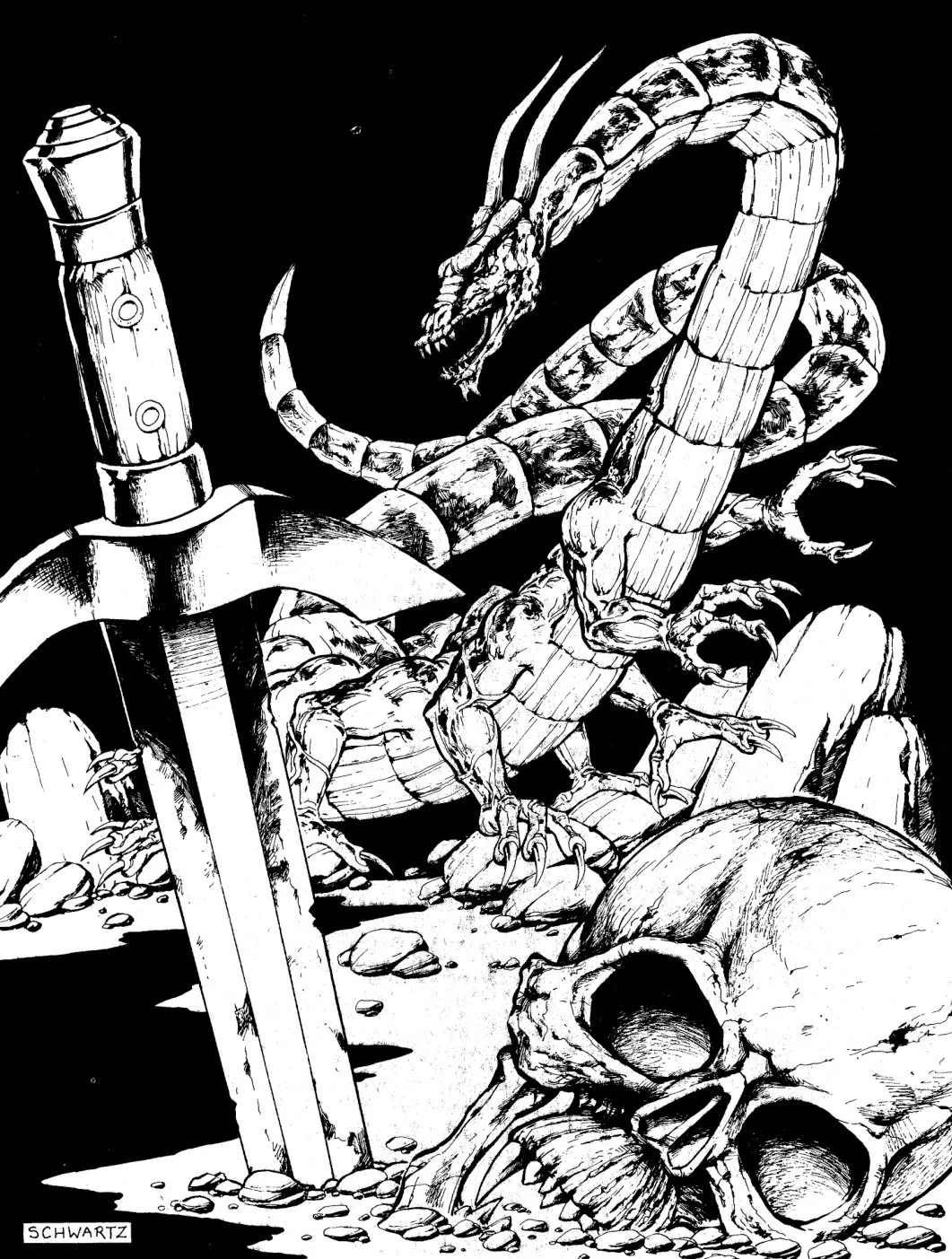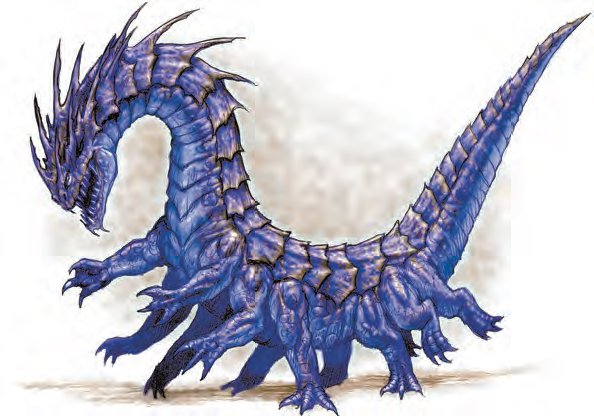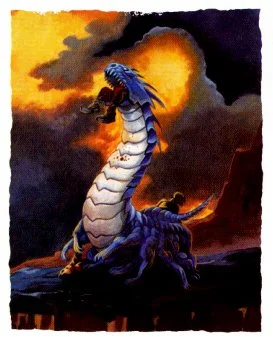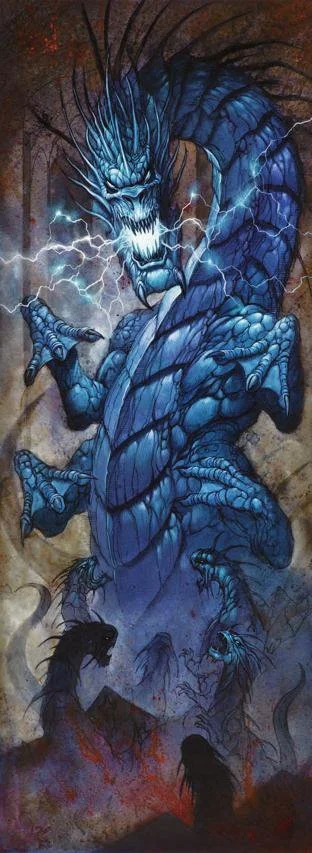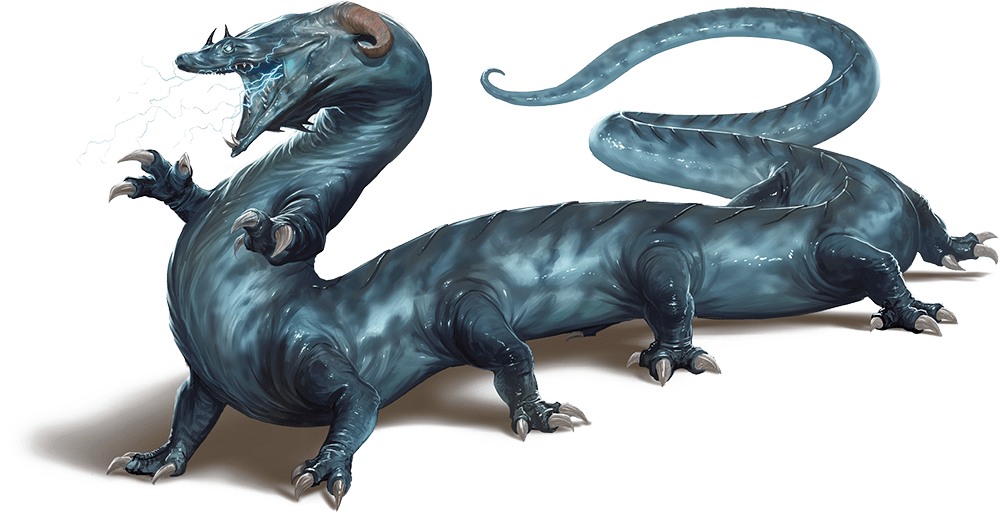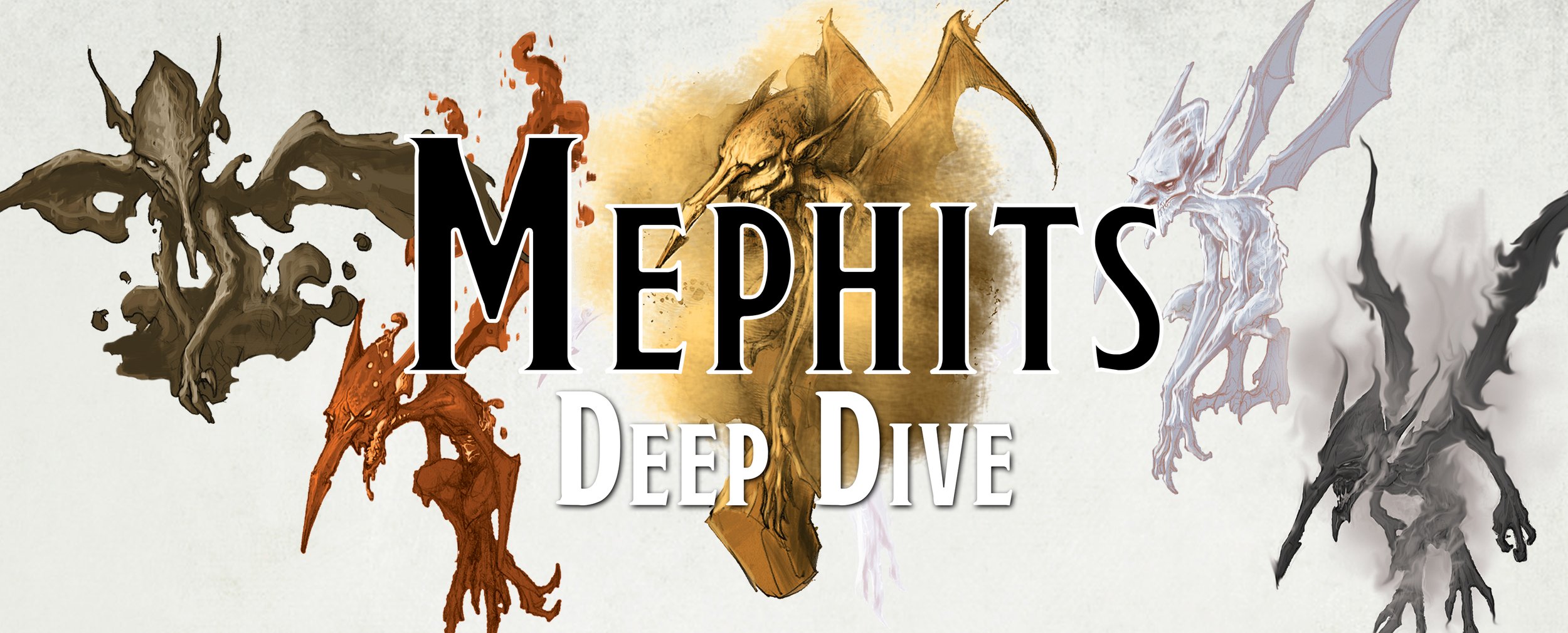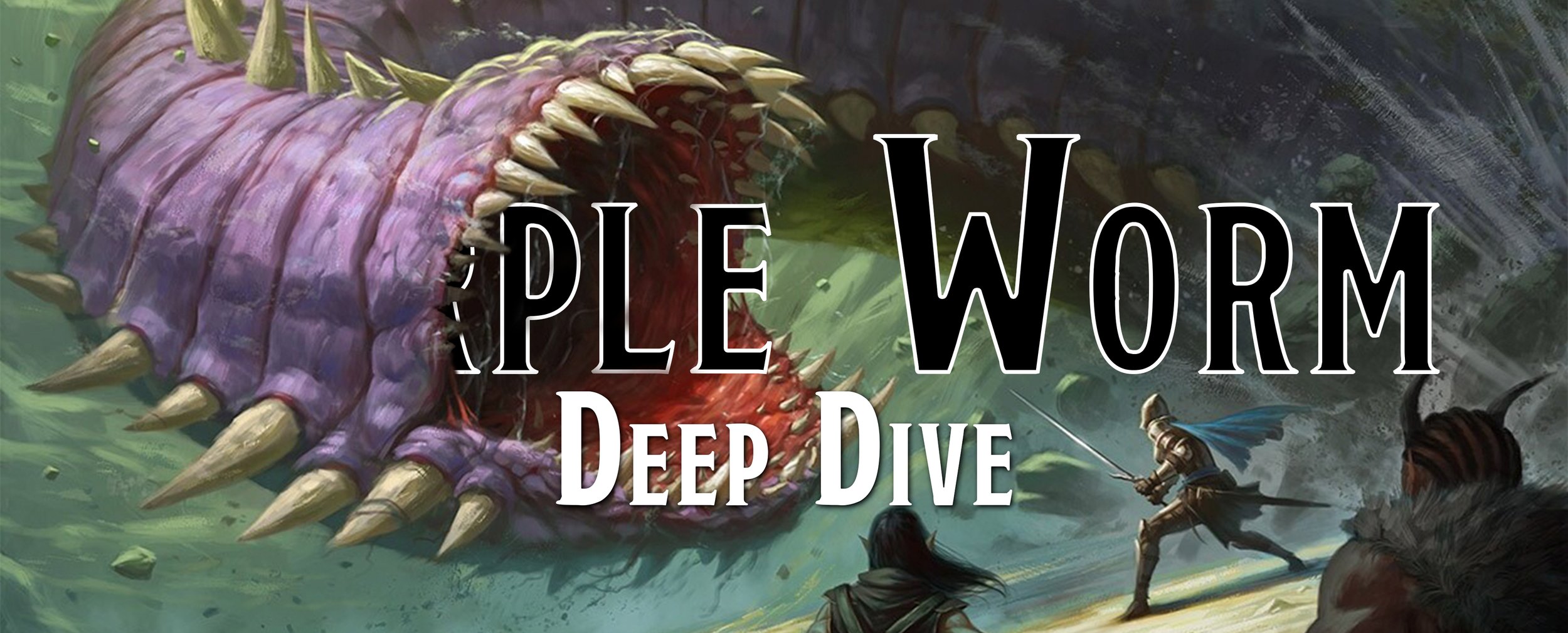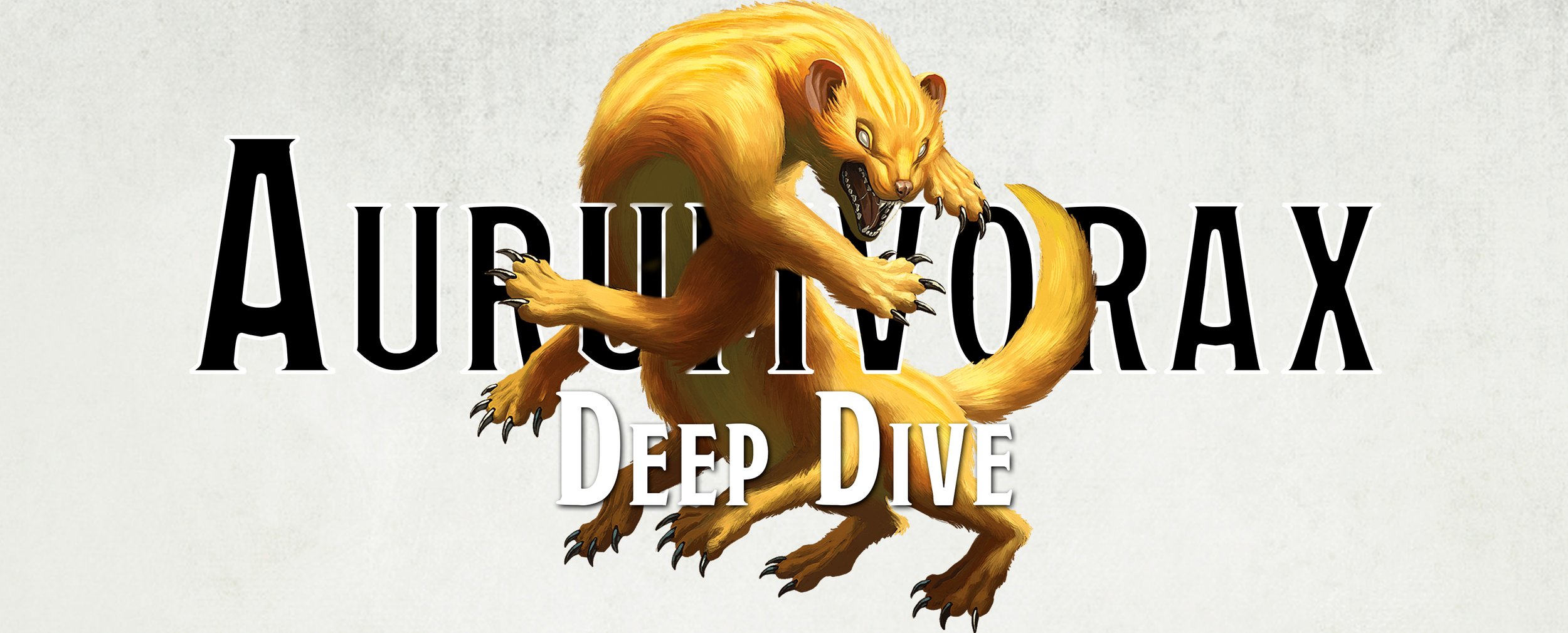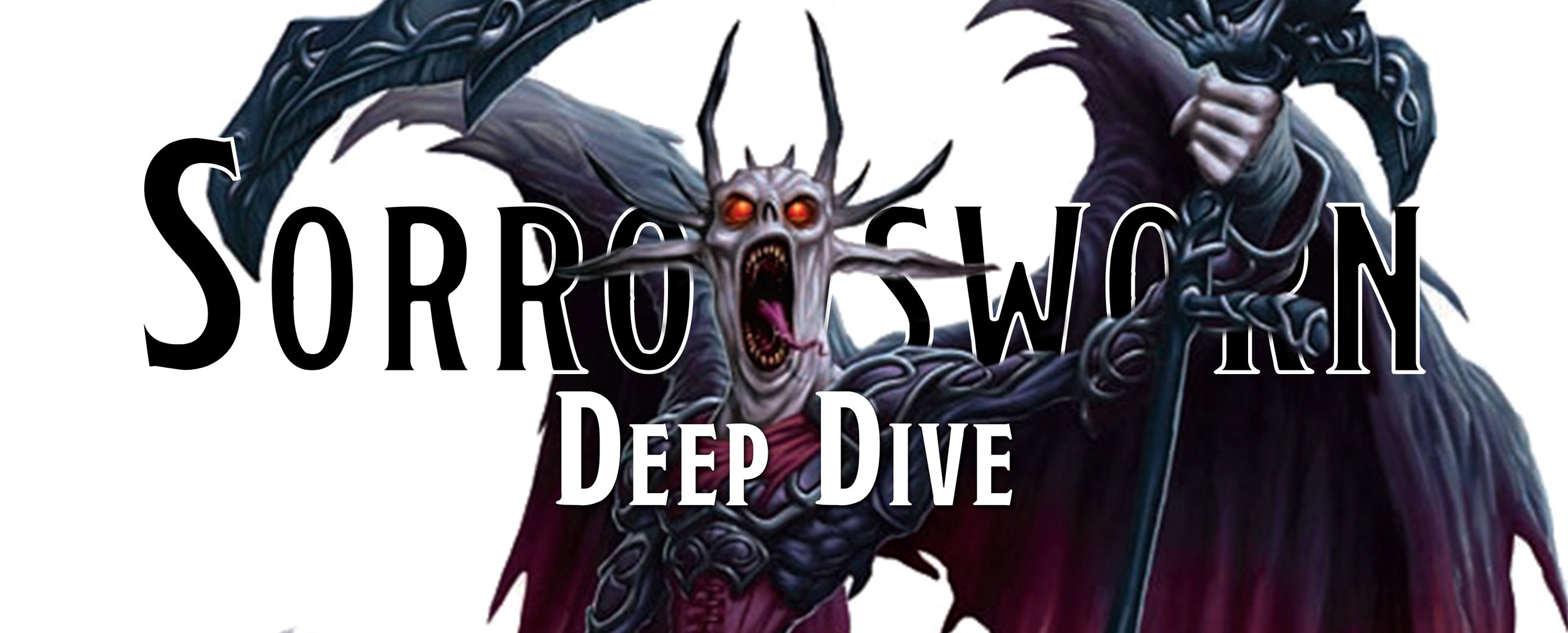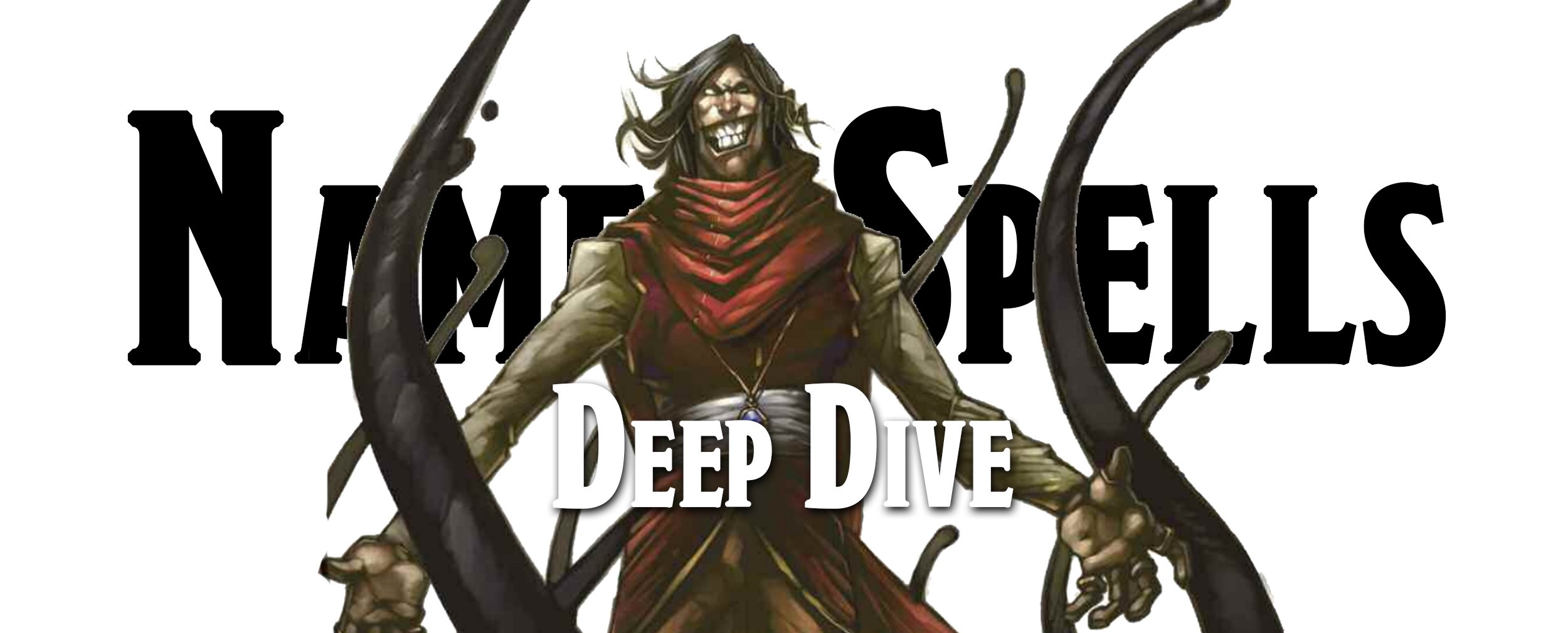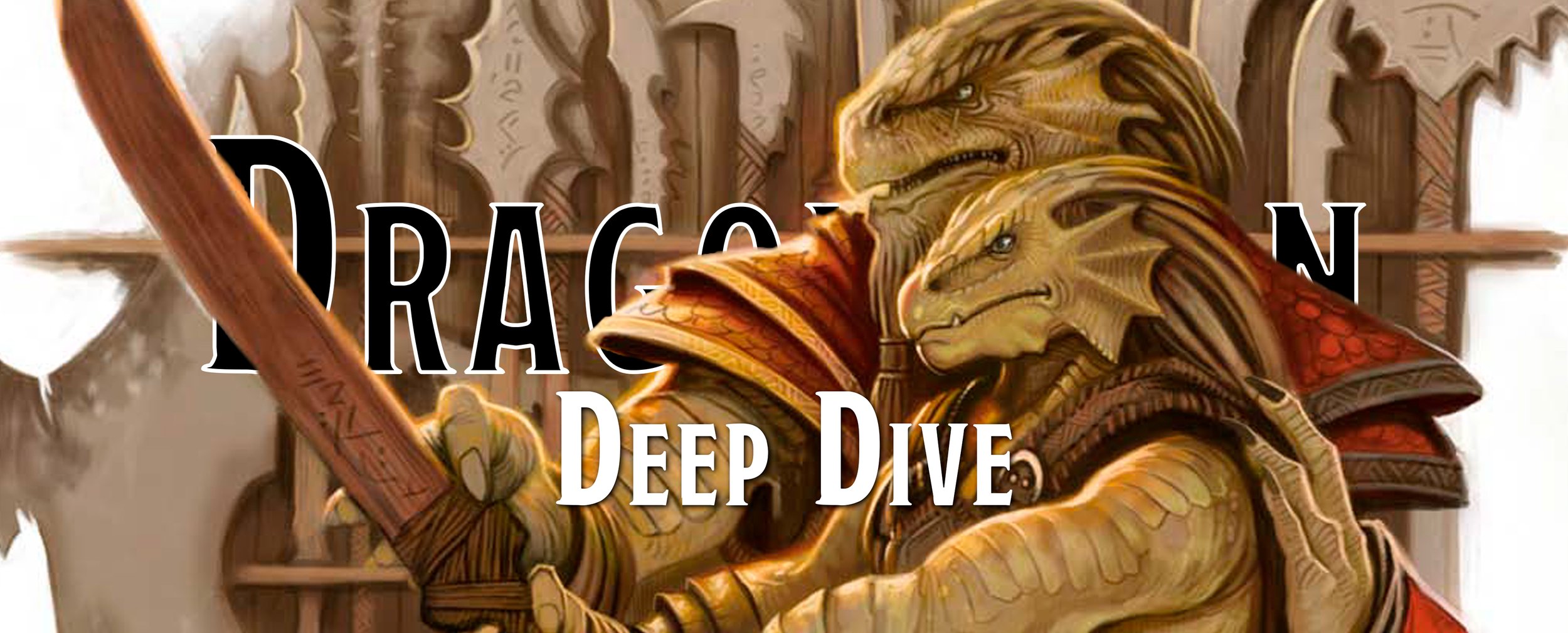Deep Dive - The Behir
The Behir is a strange electrified serpent, with twelve legs, sharp claws, and wicked horns. It sprays lightning and electricity, smashing through its prey and then quickly slithering over to gobble it up and digest it. While most adventurers might pride themselves on their dragon-slaying ability, we doubt many are as good as a Behir is at the task.
1e - Behir
Frequency: Rare
No. Appearing: 1-2
Armor Class: 4
Move: 15”
Hit Dice: 12
% in Lair: Nil
Treasure Type: See below
No. of Attacks: 1 and 1 or 1 and 6
Damage/Attack: 2-8/2-5 or 2-8/6 x 1-6
Special Attacks: Lightning bolt
Special Defenses: Immune to electricity, poison
Magic Resistance: Standard
Intelligence: Low
Alignment: Neutral evil
Size: L (40' long)
Psionic Ability: Nil
Level/X.P. Value: VII/2850 + 16/hp
Monster Manual II, 1983 TSR Inc.
We are first introduced to the Behir in the adventure S4: The Lost Caverns of Tsojcanth (1982) and reprinted in Monster Manual II (1983), and it is a ferocious reptilian snake-like monster that is quite big. They are about 40 feet long, with a dozen legs along their serpentine body, so we can only imagine how terrifying they must be when they rear back, poised to strike. Their scales range in color from aquamarine to deep blue, with bands of gray and brown. While there is no mention of them flicking their tongue out to taste the air like a snake, what they do talk about is more than enough to be terrifying.
If you stumble across this creature, or maybe the Behir slithers up to you, then you are in for a real treat. And yes, we mean slither. While a Behir might have a dozen legs, it can choose to fold its limbs close to its body and slither forth. Since there is no change in their movement whether they are using legs or not, we can assume that most Behir slither while traveling, but use their legs when they climb along cliffs and rock walls, or when shredding their enemies apart.
S4: The Lost Caverns of Tsojcanth, 1982 TSR Inc.
If you are trying to not become tonight’s meal, you are in for a difficult time. Behirs have three main ways of attacking, and it only gets worse for you with each one. First off, they attack by biting and then coiling and looping their body around you, like a constrictor snake. If they can succeed in constricting you, the next round they give you a big chomp again, followed up by six claw attacks as they start shredding you. If that isn’t enough to deal with disagreeing food, or there is a group of adventurers trying to kill them, they can unleash a line of lightning that is 20 feet long. This lightning bolt can only be used once every 10 minutes, so hopefully your fight doesn’t take long enough for them to shoot two beams of electricity.
S4: The Lost Caverns of Tsojcanth, 1982 TSR Inc.
The final note to leave you on is that Behir sometimes swallows their prey whole, meaning that all of their prey’s equipment and worldly possessions are also swallowed. This is pretty good news for you, you know if you don’t die fighting it, as you can sometimes recover those valuable items in the Behir’s stomach and digestive tract. You could find gems, jewels, magic items, or maybe your recently deceased rogue’s favorite sword.
2e - Behir
Climate/Terrain: Any land
Frequency: Rare
Organization: Solitary
Activity Cycle: Day
Diet: Carnivore
Intelligence: Low (5-7)
Treasure: See below
Alignment: Neutral evil
No. Appearing: 1-2
Armor Class: 4
Movement: 15
Hit Dice: 12
THAC0: 9
No. of Attacks: 2 or 7
Damage/Attack: 2-8 (2d4)/2-5 (1d4+1) or 2-8 (2d4)/1-6 (x6)
Special Attacks: Lightning bolt
Special Defenses: Immune to electricity, poison
Magic Resistance: Nil
Size: G (40’ long)
Morale: Champion (15)
XP Value: 7,000
Monstrous Compendium Vol. 1, 1989 TSR Inc.
The Behir appears in the Monstrous Compendium Volume 1 (1989) and is later reprinted in the Monstrous Manual (1993). There aren’t any changes to this crocodile-mouth serpent-lizard abomination, though we do get a lot of new information about these terror-snakes. They are gargantuan creatures with a tendency to shoot bolts of lightning, gobble up their enemies, and slither up to unsuspecting prey.
One new thing to keep in mind if you are stuck in combat with them is that they can swallow you whole if they score a natural 20 on their attack roll with their bite. If that happens, you are gobbled up like a tasty meat stick, and you begin to slowly be crushed and dissolved in their digestive tract. Every round you are in there, you lose one-sixth of your Hit Point maximum, meaning that after six rounds, you are very dead. If this happens, your party has a minute to kill the Behir and rescue your corpse, or else you are digested and you can no longer be raised from the dead… since your corpse has been eaten.
Luckily for you, there is a chance that you can cut your way out of the Behir! In fact, it might even be easier to fight the Behir while inside of it because its inside body has a much lower Armor Class than the super hard scales that coat its outside. Though, every round you are down there, you are taking a cumulative -1 penalty to your damage rolls, so you better hope you can kill it quickly.
Monstrous Manual, 1993 TSR Inc. / Tony DiTerlizzi
If you do actually want some good news, Behir are solitary creatures. They rarely meet up unless it is to procreate their species, and even then, the female stays back with her clutch of 1-4 eggs while the male hunts for the two of them. This lasts for about 8 months until the eggs hatch, and then like all great parents, the adult Behir immediately turn those babies out, tell them to figure it out on their own, and then the two mated pair go their separate ways.
These newly hatched Behir are only about two feet long, growing at about eight feet every year until they reach their full length of forty feet, which takes about five years. In addition, baby Behir only have six or eight legs instead of the full twelve. We guess twelve legs on a two-foot-long snake-lizard-hybrid would look weird, and so as they age, they slowly grow extra sets of legs until they have the twelve of a mature Behir.
If you hope to avoid these creatures, and we can’t blame you, Behir typically have a territory of about 400 square miles, typically residing in a high-up cliff face or a dark and deep cave. If that sounds suspiciously like a dragon’s lair, you aren’t wrong but also Behir hate all dragons and dragonkind, so don’t tell that to the Behir. Behir will attempt to run off any dragons that try to set up shop in their territory, and if that doesn’t work, the Behir will leave and find new territory that a dragon hasn’t claimed yet. They don’t like them, and we get it. The 400 square miles of territory is only big enough for one elemental-breathing lizard!
Dragon #156, April 1990 TSR Inc / Stephen Schwartz
If you are hoping for a bit more about the Behir, you are in luck with Dragon #156 (April 1990) with The Ecology of the Behir by Tony Jones. This article recounts a sage’s attempts at studying these malevolent creatures, including what the sage finds when they get ahold of a dead Behir and can study its anatomy.
What is quite interesting about Behir is that their intelligence is similar to that of a human five-year-old, and, if you catch a Behir and train it from a young age, it can learn a language and have limited communication with you. It won’t wow you with its vibrant vocabulary, but it can follow your spoken commands and even tell you how hungry it is if you start at a young enough age with the creatures. Though, if you try to catch a Behir that is a year or older, you won’t have much luck and in fact, you’ll pry get eaten for your troubles. Behir really don’t like having a master, and even a properly trained Behir will eventually turn on their master by the time they become fully mature, and decide that they’d rather not listen to orders.
In addition to reviewing the anatomy of Behir, who happen to have large sacks of metal within their stomach and in glands in the back of their mouth, probably for shooting lightning, the article also goes over two variant Behir. In total, there are three Behir you should be aware of, the common Behir, also known as the Lightning Behir, and then there are the Desert Behir and the Jungle Behir. We all know about the Lightning Behir, it shoots lightning and tears you asunder with its claws.
What you can pry guess at, is that the other Behir don’t shoot lightning. They shoot different elements, with the Desert Behir shooting a jet of flame and the Jungle Behir shooting a jet of acid. In addition, these two Behir have different scale colorings. Desert Behir, often found in the desert and volcanic plains, have scales of yellow to orange, with bands of fiery red. Jungle Behir, found in tropical jungles and rain forests, have emerald green scales and bands of coppery green. These two Behir are pretty much identical in all other regards to the Behir, meaning you really don’t want to run into them, regardless of which terrain you happen to be in.
3e/3.5e - Behir
Huge Magical Beast
Hit Dice: 9d10+45 (94 hp)
Initiative: +1
Speed: 40 ft. (8 squares), climb 15 ft.
Armor Class: 20 (–2 size, +1 Dex, +11 natural), touch 9, flat-footed 19
Base Attack/Grapple: +9/+25
Attack: Bite +15 melee (2d4+12)
Full Attack: Bite +15 melee (2d4+12)
Space/Reach: 15 ft./10 ft.
Special Attacks: Breath weapon, constrict 2d8+8, improved grab, rake 1d4+4, swallow whole
Special Qualities: Can’t be tripped, darkvision 60 ft., immunity to electricity, low-light vision, scent
Saves: Fort +11, Ref +7, Will +5
Abilities: Str 26, Dex 13, Con 21, Int 7, Wis 14, Cha 12
Skills: Climb +16, Hide +5, Listen +4, Spot +4, Survival +2
Feats: Alertness, Cleave, Power Attack, Track
Environment: Warm hills
Organization: Solitary or pair
Challenge Rating: 8
Treasure: Standard
Alignment: Often neutral
Advancement: 10–13 HD (Huge); 14–27 HD (Gargantuan)
Level Adjustment: —
Monster Manual, 2000/2003 Wizards of the Coast / Mark Tedin
The Behir bursts into this edition in the Monster Manual (2000/2003) where it remains fairly close to the previous editions, though its lore is greatly reduced. It is still a serpentine monster that slithers or runs along its dozen legs. It is described as appearing like a huge armored snake with its coloring between ultramarine and deep blue with bands of gray or brown, while its belly is pale blue, and large horns curve back over its head. One very notable change is that now all Behir speak common, so now they can insult you as they eat you.
In this version of the Behir, its combat looks fairly similar. In the first round, it makes a bite attack and then attempts a grapple against the target, on a success the target is grappled as the Behir wraps around it tight. In the subsequent round, the Behir begins to constrict by making a new grapple check. On a successful check, it deals bludgeoning damage as it begins squeezing you tighter and tighter until your eyes might burst out of your head. If that isn’t enough, it can then follow up with six claw attacks against its grappled foe, tearing them to pieces like a cat shredding its favorite toy with wicked claws.
If you decide that facing a Behir is a poor decision, we agree. If you think the solution is to go against the creature with a group, we disagree. Honestly, you should just leave them alone as a Behir can still shoot its beam of lightning, which it is happy to do when it is facing a group of adventurers who should know better. It can launch this bolt of lightning once every 10 rounds, or once a minute, so you better hope you aren’t getting hit by a second bolt or else you are probably screwed.
Dragon #333, July 2005 Paizo / Peter Bergting
While you might think it running out of lightning means your group attack will succeed, we will remind you that Behir can still swallow their prey whole, meaning that it can help give itself an edge against your team by swallowing your teammates and reducing your numbers. While you are swallowed, you can attempt to return to the fight, but you have to cut your way out, requiring you to deal 25 points of damage with a light slashing or piercing damage to its insides while you are being slowly bludgeoned by muscles and melted by acid. A light slashing or piercing weapon would include such weapons as a dagger, so you are going to be working pretty hard at cutting yourself free if that’s all you have on hand. Luckily, you won’t be lonely for long as a Behir can swallow up to two medium-sized creatures, or eight small-sized creatures, so you can at least die with a friend.
If you were hoping for a smaller Behir, you are in luck with the release of the Shining South (2003) sourcebook for the Forgotten Realms campaign setting. The Halruaan Behir is a much smaller, inbred version of the Behir, though they are still quite dangerous. They have the normal attacks and abilities of a common Behir, though they rarely reach 20 feet long and come in a brilliant array of colors.
These more colorful Behir, featuring green, coral, or rose-hued scales, are the results of breeders attempting to create the most fantastic version of these small Behir, though the result of centuries of breeding has left these Behir rather dumb. They can no longer speak a language, their intelligence is reduced, and they are a bit less clever than proper Behir, but at least you don’t have to worry about your very intelligent pet deciding that they’d rather eat you for lunch.
Dragon #333, July 2005 Paizo / Peter Bergting
The Behir gets to join a very exclusive club, being featured in not just one, but two Ecology of articles, this time appearing in Dragon #333 (July 2005) written by Eric Cagle. Only three other monsters we’ve covered have had two Ecology of articles written about them, with the green hag, harpy, and the rust monster. In this article, we are given a closer look at a voracious predator with draconic deadliness, giving the Behir its proper due of being a canny and clever predator.
This article features plenty of information to sink our teeth into, but the major things we want to talk about are where the Behirs originate from and their mastery over lightning. No one is completely sure where the Behir originate from, or who might’ve made them. Some think that they may be the children of a rather cruel and voracious deity, like Merrshaulk or Apep, others believe that they are the augmented children of dragons. Perhaps an especially large lizard had a wonderful evening with a blue dragon, though don’t try to suggest to any dragon you meet that that is how Behirs were created. All dragons, but blue dragons especially, hate and despise anything with Behirs and they won’t take any insinuation about them and lizards very well.
The other theory is that a blue dragon wanted to create draconic guardians and experimented on her eggs to try and create drake guards. This is similar to how the first Ecology of article blamed Behirs on wizards going mad with magical experiments, but this time it is a blue dragon who tried to be god.
Dragon #333, July 2005 Paizo / Peter Bergting
Up next is the crackling lightning that arcs up and down the spines of the Behir. These sparks are always crackling, as the Behir is constantly producing electrical energy. In fact, the organs that sages believe are responsible for producing the lightning breath are located right next to a Behir’s brain, which may be the explanation for why Behir are rather temperamental. Behir typically have wild mood swings, often changing their mind within ten minutes and experiencing intense emotions, though mostly violent emotions. Some believe that these sparks are constantly damaging the Behir’s brain, causing these violent outbursts and sudden fits of rage followed by a quick and unnatural calm that overcomes the magical beasts.
4e - Behir
Level 14 Solo Soldier
Huge natural magical beast / XP 5,000
Initiative see lightning reflexes
Senses Perception +12; tremorsense 10
Lightning Storm aura 5; an enemy that starts its turn in the aura takes 5 lightning damage.
HP 564; Bloodied 282
AC 30; Fortitude 27, Reflex 26, Will 26
Resist 15 lightning
Saving Throws +5
Speed 7, climb 5
Action Points 2
Claw (standard; at-will) Reach 3; +21 vs. AC; 2d8 + 6 damage.
Bite (standard; at-will) ✦ Lightning Reach 3; +21 vs. AC; 1d8 + 6 damage plus 1d8 lightning damage.
Devour (standard; recharges when no creature is affected by this power) Reach 3; +19 vs. Reflex; 2d8 + 6 damage, and a Medium or smaller target is swallowed. A swallowed target is grabbed and restrained. A swallowed creature has line of sight and line of effect only to the behir, and no creature has line of sight or line of effect to it. A creature that escapes the grab is no longer swallowed and appears in a space adjacent to the behir. A behir can move normally while it has a target grabbed in this way. When the behir dies, the target can escape as a move action, appearing in the behir’s former space. Sustain Minor: The behir sustains the grab, and the target takes 15 damage.
Lightning Breath (standard; recharge ⚄ ⚅) ✦ Lightning Close blast 5; +17 vs. Reflex; 3d10 + 6 lightning damage and the target is dazed. Miss: Half damage.
Thunderleg Stomp (standard; at-will) Close burst 3; +17 vs. Fortitude; 1d8 + 6 damage, and the target is knocked prone.
Lightning Reflexes The behir acts three times in a round, on initiative counts 30, 20, and 10. It cannot delay or ready actions. On each turn, it has a standard action instead of the normal allotment of actions. It can use one immediate action between each pair of turns.
Alignment Unaligned / Languages Common, Draconic
Skills Stealth +13
Str 23 (+13) Dex 20 (+12) Wis 21 (+12) Con 21 (+12) Int 7 (+5) Cha 13 (+8)
Monster Manual 2, 2009 Wizards of the Coast / Wayne England
The Behir slithers into this edition in Monster Manual 2 (2009), and while we are upset that they had to wait a whole year to be introduced, we are excited that they bring with them three versions of Behir to unleash upon a certain foolish band of adventurers who are quite conductive. One big thing we want to make sure everyone knows is that the Behir can now speak draconic, we aren’t sure why in the previous edition their only language was common, and not the language of dragons, but it’s been rectified. You can now hear the Behir tell you in two languages just how tasty you are.
What lore is provided isn’t especially new for the Behir and is what we have already covered. They are vicious and ill-tempered, they hate true dragons, they are powerful predators, and they are not-so-good at parenting as they throw their baby Behir out shortly after birth. What is new is that the Behir may be the pets of giants, storm giants to be specific. These giants use the Behir as mounts, probably very excited about all the lightning that the Behir is outputting, and the two charge into their enemies in a burst of electricity.
The three Behir are the Behir, Behir Bolter Whelp, and the Behir Stormsteed. The Behir is our classic Behir flavor, filled with lightning, and a desire to devour foolish adventurers, but no raking ability against creatures it has grappled. What it does have is its Lightning Reflexes ability that allows it to act three times every round, gaining a single action to use on each turn. This means that for its first turn in the round, it may just run up to you, and then it has to wait until its next turn to spray its lightning breath or to make a devastating bite attack against you. With its third action that round, probably after everyone else has gone, it then gets to do another action, like stomping you into the ground in a burst of thunder and lightning.
Dungeon #159, Oct. 2008 Wizards of the Coast
The Behird Bolter Whelp takes your standard Behir, and makes it a young Behir all ready to rip and tear its first adventurer. It gets a unique ability to make a claw attack against a creature that hurts it, but otherwise, it behaves and murders just like a real Behir. The Stormsteed, the last one in this book, loses its claw attack, but gains the ability to make extra bite attacks or use its breath weapon even if it has already taken a different action that turn.
While the Behir does get to show up three more times across multiple adventures, none evolve the lore and even provide much new information. The first adventure, The Lost Mines of Karak by Greg A. Vaughan, in Dungeon #159 (Oct. 2008) features the Juvenile Behir Thunderlance for a brief encounter. After that is the adventure book Revenge of the Giants (2009) featuring the Behir Young Adult. Lastly, the Icetouched Behir appears in Dungeon #165 (April 2009) in the adventure, Alliance at Nefelus by Chris Tulach. In each of these adventures, the Behir is simply there to provide support to giants and other monsters, before being swept away by a group of powerful adventurers.
5e - Behir
Huge monstrosity, neutral evil
Armor Class 17 (natural armor)
Hit Points 168 (16d12 + 64)
Speed 50 ft., climb 40 ft.
Str 23 (+6) Dex 16 (+3) Con 18 (+4) Int 7 (−2) Wis 14 (+2) Cha 12 (+1)
Skills Perception +6, Stealth +7
Damage Immunities lightning
Senses darkvision 90 ft., passive Perception 16
Languages Draconic
Challenge 11 (7,200 XP)
Multiattack. The behir makes two attacks: one with its bite and one to constrict.
Bite. Melee Weapon Attack: +10 to hit, reach 10 ft., one target. Hit: 22 (3d10 + 6) piercing damage.
Constrict. Melee Weapon Attack: +10 to hit, reach 5 ft., one Large or smaller creature. Hit: 17 (2d10 + 6) bludgeoning damage plus 17 (2d10 + 6) slashing damage. The target is grappled (escape DC 16) if the behir isn’t already constricting a creature, and the target is restrained until this grapple ends.
Lightning Breath (Recharge 5–6). The behir exhales a line of lightning that is 20 feet long and 5 feet wide. Each creature in that line must make a DC 16 Dexterity saving throw, taking 66 (12d10) lightning damage on a failed save, or half as much damage on a successful one.
Swallow. The behir makes one bite attack against a Medium or smaller target it is grappling. If the attack hits, the target is also swallowed, and the grapple ends. While swallowed, the target is blinded and restrained, it has total cover against attacks and other effects outside the behir, and it takes 21 (6d6) acid damage at the start of each of the behir’s turns. A behir can have only one creature swallowed at a time. If the behir takes 30 damage or more on a single turn from the swallowed creature, the behir must succeed on a DC 14 Constitution saving throw at the end of that turn or regurgitate the creature, which falls prone in a space within 10 feet of the behir. If the behir dies, a swallowed creature is no longer restrained by it and can escape from the corpse by using 15 feet of movement, exiting prone.
Monster Manual, 2014 Wizards of the Coast
The Behir’s last curtain call is in the Monster Manual (2014) and features our favorite blue serpentine lizard as a ferocious, dragon-hating snake. Though, this time, it isn’t compared to lizards and dragons, instead, it is the combination of a centipede and crocodile. While we get the crocodile muzzle, we aren’t so sure about the centipede comparison, though we guess it comes down to having a few more legs than most terrestrial lizards.
This edition doubles down on giants and provides a new progenitor for the highly anti-dragon species. Long ago, and probably still today, giants and dragons warred, attempting to annihilate each other from the face of the multiverse. To assist in their epic struggle, storm giants created the first Behirs as weapons to destroy dragons, imbuing electrical powers and an unending and innate hatred for dragonkind, though they do speak draconic so we guess that not all dragon-things are bad. This hatred exists all of a Behir’s life and they will never willingly set up their home in a place controlled by a dragon, though they will try their best to drive the dragon out. If that fails, they’ll lick their wounds and find a new place with no dragons around to settle down in.
The Behir in this edition fights quite closely to how it is presented in other editions, though it lacks a true rake or claw attack it had before. Instead, each turn it can make a bite and constrict attack, chomping on its enemies and squeezing them tightly. When it constricts, it deals not just bludgeoning damage, but also slashing damage, so we suppose that that is a call-back to the vicious raking past Behirs would provide to anyone they were hugging. In addition, they still shoot beams of lightning and will happily swallow any creature whole that can fit in their mouth. If you end up in there, you better hope you can deal at least 30 damage in a single turn, or else you will be digested and take up to 36 points of acid damage. Hopefully, your party is willing to fight a literal dragonslayer on electrical steroids.
The Behir is a dangerous and cruel species of giant lizard. They have some intelligence, with it slowly increasing across the editions and giving them just a bit more personality to work with. Their hatred of dragons is well known and we suggest you give them a wide berth… or at least, don’t stand in a straight line with your allies. You may find the outcome shocking.
If you enjoy our Deep Dive series, consider
supporting us on Patreon and following us on Twitter!


